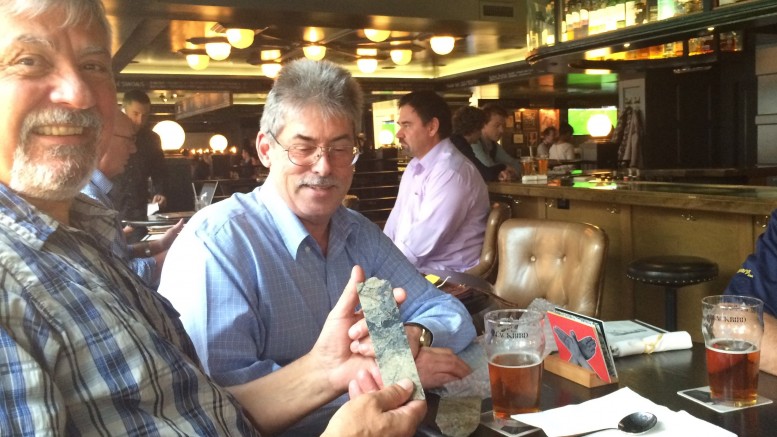VANCOUVER — The latest drill results from Serengeti Resources’ (TSXV: SIR) Kwanika copper-gold project, 250 km east of Smithers, may have triggered a 35% drop in the company’s share price, but Serengeti president and CEO David Moore insists they are “terrific” results.
Holes 177 — drilled into the heart of Kwanika’s Central zone copper-gold resource — returned some of the highest grades at the project to date: 438 metres grading 0.7% copper and 0.83 gram gold per tonne, including 234 metres of 1.2% copper and 1.3 grams gold.
Hole 179, which tested down-dip and northwest of Central, returned a 235-metre interval of 0.2% copper and 0.15 gram gold. The hole bottomed in another 59-metre mineralized interval of 0.3% copper and 0.29 gram gold from 846 metres deep.

A map of Serengeti Resources’ Kwanika copper-gold projects near Smithers, B.C., showing a deep induced-polarization target and Central Zone resource area relative to 2016 drill holes. Credit: Serengeti Resources.
The last hole in the 2,500-metre program, 178, tested a deep induced polarization (IP) chargeability anomaly, which the company says could represent a mineralized centre 900 metres north of 177. The hole hit 245 metres of 0.1% copper and 0.11 gram gold before the mineralization was cross-cut with a fault and a younger intrusive.
“Perhaps the market expected us to deliver a discovery in our exploration holes, but we’re really pleased with the results,” Moore tells The Northern Miner from the company’s office in Vancouver.

At Serengeti Resources’ Kwanika gold-copper project in B.C., a conceptual map with a southwest view of mineralized intercepts from 2016 drilling relative to a deep IP anomaly. Credit: Serengeti Resources.
“We were hoping to find a system but the next best thing would be to establish a vector, and the resounding answer to that is that this deeper IP target is very much alive. Everything we saw in the holes — both in metal distribution and alteration, along with the geophysics — indicates that we are still in the carapace to a mineralized porphyry, it just needs more drilling,” he says.
The IP anomaly, which Moore says 178 skirted over, suggests that mineralization could extend up to 1 km north of the Central zone below prior drilling, giving Kwanika more room to grow.
“Over the past five years, there’s been a lot of recognition that these alkali systems have extraordinarily persistent, high-grade roots,” Moore says, using AuRico Metals’ Kemess Underground copper-gold project, 150 km north of Kwanika, and New Gold’s New Afton mine in Kamloops, B.C., as supporting examples.

A map of Serengeti Resources’ Kwanika property location and related infrastructure in northern British Columbia. Credit: Serengeti Resources.
“The roots of these systems are the future for B.C. porphyries, and that potential exists at Kwanika,” he says. “We haven’t hit the barn-burner hole yet, but we think we’re on the doorstep.”
The company plans to incorporate the drill results into a revised resource estimate for the Central zone, which, according to a 2011 estimate, hosts 243.6 million indicated tonnes of 0.2% copper and 0.21 gram gold, and 55.2 million inferred tonnes of 0.1% copper and 0.14 gram gold.
The calculations use a US$7.5-per-tonne cut-off within a conceptual, open-pittable shell.
Moore says that 177 was drilled perpendicular to drill holes used in previous resource calculations, in order to to deliver data that would improve modelling in the upcoming estimate.
“We’re trying to determine the highest-grade domain, because that’s what we envision as becoming a potentially economic starter project. Then we can focus on additional centres of high-grade mineralization, which will likely come from a buried system,” he says.

From left: Posco Daewoo’s Ji Su Go and Kyu-Youl Sung, and Serengeti Resources geologist Cole Godfrey at a drill site on Serengeti’s Kwanika property in British Columbia. Credit: Serengeti Resources.
Serengeti’s drill program has been funded by Daewoo Minerals Canada, a subsidiary of Posco-Daewoo, one of South Korea’s leading trading corporations, as part a deal signed in April.
Moore says that by the end of the current program, Daewoo will have earned a 5% interest in the project after paying Serengeti $400,000 in cash, and reaching $800,000 in expense commitments on the project in the first year.
Early next year, Daewoo could begin to earn another 30% interest by committing $7 million over the next two years.
The project also hosts the South zone, a copper-molybdenum-gold-silver porphyry located 2 km south of Central zone.
The porphyry has an open-pittable, inferred resource of 240 million tonnes of 0.2% copper and 0.09 gram gold, assuming a US$7.50-per-tonne cut-off.
Both deposits occur within fault-bounded blocks next to a northwest-trending, terrane-bounding structure called the Pinchi fault.
An irregular conglomeratic unit overlying the Central zone helped preserve a 5- to 70-metre-thick, copper-enriched supergene zone, which is unusual mineralization to see in porphyry deposits of the Canadian Cordillera.
Shares of Serengeti have traded in a 52-week range of 1¢ to 33¢, and closed at 16¢ at press time. The company has 69.9 million shares outstanding for a $10.5-million market capitalization.


Be the first to comment on "Upside ‘very much alive’ at Kwanika in BC, Serengeti says"